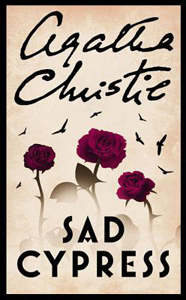While I don’t know why Agatha Christie goes with a Shakespeare phrase to title “Sad Cypress” (1940) – main character Elinor is sad, but she’s not a tree – I really liked this novel. It ends up featuring a lot of mystery staples, but it’s intensely focused on characters.
Something different, at first
At first, it feels like something totally different from Christie, then when Poirot enters it zips to the finish line in page-turning fashion. But it doesn’t lose that initial impression of a novel that stands out from the pack. Ultimately, “Sad Cypress” demonstrates that Christie is a good writer, period, not merely a good genre writer.
Christie, who had written two Mary Westmacott (non-mystery) novels by this point, chronicles the inner romantic feelings in a love rectangle that starts with non-blood cousins Elinor and Roddy.

“Sad Cypress” (1940)
Author: Agatha Christie
Genre: Mystery
Series: Hercule Poirot No. 21
Setting: Hunterbury, United Kingdom
They’ve known each other since childhood, still remember those great times at the Hunterbury estate, and are essentially best friends. The idea of getting married and living in their aunt’s (by blood on Elinor’s side, by marriage on Roddy’s) large house has a comfortable appeal.
Then there’s the irrational kind of love that’s new to both of them. Roddy is smitten by Mary, a fascinating young thing. Elinor catches the eye of doctor Peter, who impresses upon Poirot (making one of those mid-book entrances) to find evidence in Elinor’s favor in her murder trial.
Taking the story to court
Structurally, it’s a fresh idea to start with a snatch of Elinor’s trial, then flash back to “Here’s how we got to this point” (although “Appointment with Death” is similar).
And having so much courtroom action is new for Christie. The lawyer’s preparations are left off page. (But it’s pleasant to discover he’s good at his job. And the trial ends up being engaging.)
As usual, it’s Poirot’s work we’re concerned with. Plot points involve poisonings and wills and secret identities, so there’s nothing new there.
A sympathetic lead
Yet “Sad Cypress” feels special among Christie works to this point. It’s because she’s so plugged into her characters.
Elinor is a good and honest person, but not at all in a boring way. Elinor loves Roddy to the point where she wants him to explore his feelings for Mary, and isn’t mad at him for having those feelings.
She’s rational, a little too selfless for her own good, and a little sad. Her love for Roddy makes for the purest romance Christie has written to this point.
We also get a good sense of the inner and outer beauty of Mary through the many people Poirot interviews about her. The tragedy of a young life snuffed out is palpable. So we don’t end up hating Roddy; we’re enthralled by Mary too.
Christie presents aunt Laura Welman’s strokes and invalid status in an unusually real fashion. Mrs. Welman even expresses interest in a merciful assisted suicide. In “Sad Cypress,” death (and the prospect thereof) isn’t merely a story function – something that triggers wills and inheritances (although, of course, it does that) — but something Christie stops to think about.
Some old standbys
Granted, this book also includes those highly amusing chapters wherein Poirot interviews witnesses who hold a colorful one-note view of the world. For example, there’s the housekeeper who distrusts foreigners like Poirot. But the skilled Poirot smoothly mentions his visit to English royalty, and his interviewee then holds him in higher esteem.
Those chapters only make Elinor stand in more contrast.
While Poirot has something to say about Elinor’s psychology, he’s not exactly using psychology to solve the case. He is doing rock-solid detective work, also employing ill-defined contacts for off-page legwork.
As for the mystery’s solution, it’s the familiar thing of Poirot being better at his job than everyone else. But it’s satisfying to watch Christie rearrange old building blocks. And it’s remarkable that Poirot – while remaining his confident self – does not upstage Elinor and those in her sphere.
Christie has mixed romances and mystery before, but usually in the style of a fun romp. In “Sad Cypress,” the mix is sober and serious, with the emotional and plot threads smoothly interweaving to an honest conclusion on both fronts.
Every week, Sleuthing Sunday reviews an Agatha Christie book or adaptation. Click here to visit our Agatha Christie Zone.


